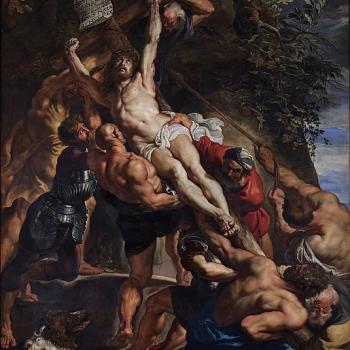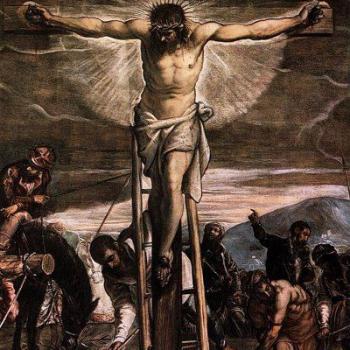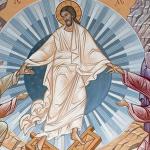The Shroud of Turin is a linen cloth long venerated as the burial shroud of Jesus Christ. The blood-stained cloth bears an image–later discovered to be, in effect, a photographic negative–of a man who had been crucified.
Physicians confirmed that the image showed an actual scourged and human body that had been nailed to a cross and stabbed with a spear. Archaeologists, historians, and pollen experts placed the artifact in ancient Palestine. In 1981 researchers said that the image is “not the product of an artist,” that “no chemical or physical methods known … can account for the totality of the image,” which has a consistent depth of only two micro-fibers and which, unlike paint or similar material, does not penetrate the cloth.
Some Christians considered the Shroud of Turin to be scientifically-verifiable proof of the Resurrection of Christ, a 2000-year-old photograph made by energy emitted at the moment that He rose from the dead.
But then in 1988, the Vatican consented to radiocarbon dating of the relic and the researchers threw cold water on all of these claims. They found that the samples dated between 1260 and 1390. However the image was formed, the Shroud of Turin had to be a medieval forgery.
Some critics noted that the three cloth samples were all taken from the same location, the outer edge of the cloth. It has long been known that the Shroud was often mended and repaired through the ages. In 2005, Raymond A. Rogers published an article Thermochimica Acta that concluded, in the words of the abstract,
The radiocarbon sampling area is uniquely coated with a yellow–brown plant gum containing dye lakes. Pyrolysis-mass-spectrometry results from the sample area coupled with microscopic and microchemical observations prove that the radiocarbon sample was not part of the original cloth of the Shroud of Turin. The radiocarbon date was thus not valid for determining the true age of the shroud.
Recently, French and Italian researchers have gained access–long denied–to the original raw data of the 1988 study. They reported serious flaws in the methodology and in the findings. They criticized the way the 1988 researchers took all of their samples from the same location on the cloth. Good practice would have been to take samples from different parts of the cloth.The samples themselves were “heterogeneous” in their dates and composition, suggesting that they were not representative of the cloth as a whole. The researchers called for a new radiocarbon dating.
Concludes lead researcher Tristan Casabianca,
Our statistical analysis shows that the 1988 carbon 14 dating was unreliable: the tested samples are obviously heterogeneous, [showing many different dates], and there is no guarantee that all these samples, taken from one end of the sheet, are representative of the whole fabric. It is therefore impossible to conclude that the shroud of Turin dates from the Middle Ages.
For the scholarly article on the findings, published in Archaeometry from Oxford University, go here.
We Lutherans are highly skeptical of relics and of the possibility of some definitive all-persuasive proof of the Christian faith. After all, faith comes by hearing of the Word. And “I believe that I cannot by my own reason or strength believe in Jesus Christ, my Lord, or come to Him; but the Holy Spirit has called me by the Gospel, enlightened me with His gifts, sanctified and kept me in the true faith” (Small Catechism, Third Article of the Creed).
As the Wikipedia article on the Shroud shows, there is an enormous amount of evidence on both sides of the question of the relic’s authenticity. Raw data must be interpreted and lends itself to being interpreted differently. I strongly suspect that a pre-existent faith or the lack thereof shapes the conclusions.
Then again, some people of faith are also skeptical. One commenter on this blog, in an earlier post on the subject, said that the Shroud could not be genuine, since the Bible specifies that Joseph of Arimathea “bound” Jesus’ body in “linen cloths,” plural (John 19:40). But the synoptic Gospels say that His body was wrapped in a “linen shroud,” singular (Matthew 27:59, Mark 15:46, Luke 23:53). This is not a contradiction. One large shroud does not preclude the use of other cloths, which might have been used to “bind” the larger cloth that was wrapped around the body.
If Christ’s resurrection or other Biblical events left behind physical artifacts, they can’t create faith apart from the Word (though how would anyone recognize what they are apart from the Word?). Nevertheless, they can serve as reminders that Christianity is grounded in historic events that really happened. And they can be testimonies to our particular times and mindsets, leaving us without excuse.
But even authentic relics don’t need to be venerated in the Roman Catholic manner. So the custodians of the Shroud would do well to allow for a few more cuttings from the cloth in an effort to settle the interesting historical question of the Shroud’s date one way or the other.
Photo: Shroud of Turin, positive and negative image (detail) by Dianelos Georgoudis [CC BY-SA 3.0 (https://creativecommons.org/licenses/by-sa/3.0)] via Wikimedia Commons

















